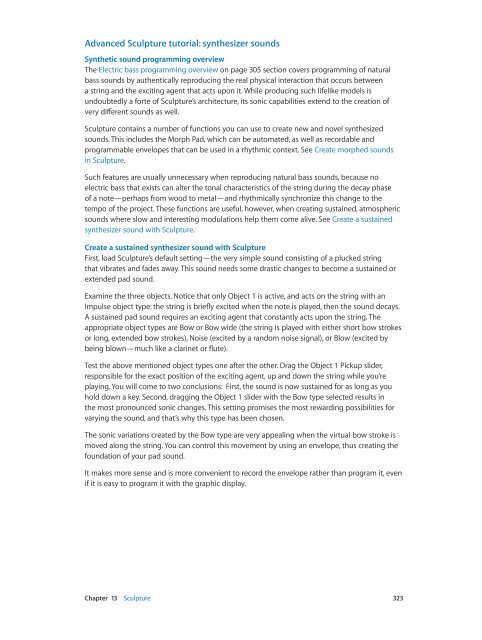Apple MainStage 3 Instruments - MainStage 3 Instruments
Apple MainStage 3 Instruments - MainStage 3 Instruments
Apple MainStage 3 Instruments - MainStage 3 Instruments
You also want an ePaper? Increase the reach of your titles
YUMPU automatically turns print PDFs into web optimized ePapers that Google loves.
Advanced Sculpture tutorial: synthesizer sounds<br />
Synthetic sound programming overview<br />
The Electric bass programming overview on page 305 section covers programming of natural<br />
bass sounds by authentically reproducing the real physical interaction that occurs between<br />
a string and the exciting agent that acts upon it. While producing such lifelike models is<br />
undoubtedly a forte of Sculpture’s architecture, its sonic capabilities extend to the creation of<br />
very different sounds as well.<br />
Sculpture contains a number of functions you can use to create new and novel synthesized<br />
sounds. This includes the Morph Pad, which can be automated, as well as recordable and<br />
programmable envelopes that can be used in a rhythmic context. See Create morphed sounds<br />
in Sculpture.<br />
Such features are usually unnecessary when reproducing natural bass sounds, because no<br />
electric bass that exists can alter the tonal characteristics of the string during the decay phase<br />
of a note—perhaps from wood to metal—and rhythmically synchronize this change to the<br />
tempo of the project. These functions are useful, however, when creating sustained, atmospheric<br />
sounds where slow and interesting modulations help them come alive. See Create a sustained<br />
synthesizer sound with Sculpture.<br />
Create a sustained synthesizer sound with Sculpture<br />
First, load Sculpture’s default setting—the very simple sound consisting of a plucked string<br />
that vibrates and fades away. This sound needs some drastic changes to become a sustained or<br />
extended pad sound.<br />
Examine the three objects. Notice that only Object 1 is active, and acts on the string with an<br />
Impulse object type: the string is briefly excited when the note is played, then the sound decays.<br />
A sustained pad sound requires an exciting agent that constantly acts upon the string. The<br />
appropriate object types are Bow or Bow wide (the string is played with either short bow strokes<br />
or long, extended bow strokes), Noise (excited by a random noise signal), or Blow (excited by<br />
being blown—much like a clarinet or flute).<br />
Test the above mentioned object types one after the other. Drag the Object 1 Pickup slider,<br />
responsible for the exact position of the exciting agent, up and down the string while you’re<br />
playing. You will come to two conclusions: First, the sound is now sustained for as long as you<br />
hold down a key. Second, dragging the Object 1 slider with the Bow type selected results in<br />
the most pronounced sonic changes. This setting promises the most rewarding possibilities for<br />
varying the sound, and that’s why this type has been chosen.<br />
The sonic variations created by the Bow type are very appealing when the virtual bow stroke is<br />
moved along the string. You can control this movement by using an envelope, thus creating the<br />
foundation of your pad sound.<br />
It makes more sense and is more convenient to record the envelope rather than program it, even<br />
if it is easy to program it with the graphic display.<br />
Chapter 13 Sculpture 323
















